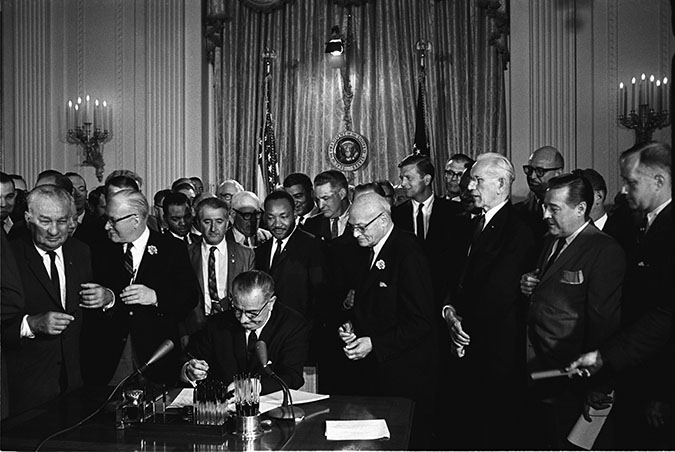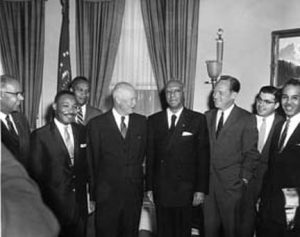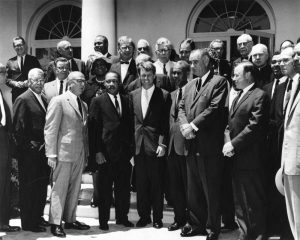
My father sat in the Ebenezer Baptist Church, fifty years ago today, on April 9, 1968, with Vice President Humphrey who came to attend the funeral of Dr. Martin Luther King, Jr.
*****
During the last few weeks, for the 50th anniversary of the assassination of Dr. Martin Luther King Jr., the city of Atlanta has featured events, articles, and documentaries about its noble son. The more I learn about him, the more I appreciate this iconic civil rights leader who peacefully fought for racial equality. Furthermore, as I studied my father’s history, I am struck by the close proximity from which he witnessed Dr. King’s journey during this critical period of the Civil Rights Movement.
Though my father was raised in West End, Atlanta, only one mile from Morehouse College, Dr. King’s alma mater, it was in our nation’s capital where my father first met Dr. King. Over the years, Dr. King and other prominent civil rights leaders met with Presidents Eisenhower, Kennedy, and Johnson during my father’s tenure in the Secret Service.


My father was stationed in the East Room of the White House–not far from where Dr. King stood–as LBJ signed the groundbreaking Civil Rights Act on July 2, 1964. My father was also on duty when Dr. King came to the White House again after the 1965 Voting Rights Act and the 1968 Civil Rights Act were passed. Lastly, my father accompanied Vice President Hubert H. Humphrey to Atlanta to attend Dr. King’s funeral.
On the evening of April 4, 1968, upon the tragic assassination of Dr. King, my father rushed to the White House where he remained for the next few days to be among those protecting President Johnson as riots ensued and major cities burned across the nation. Of those days, my father wrote:
“Helmets and gas masks were brought out … and the helicopter …was kept in readiness should it become necessary to evacuate the president. I shall never forget the feeling I experienced early Sunday morning as …[we] stood at the base of the South portico with the president. Troop carriers moved along the streets beyond the White House gates, carrying steel-helmeted, combat-ready soldiers. It was one of the few times that troops had been needed to patrol the capital since the Civil War.…it seemed almost incomprehensible that this was really happening. I felt a lump in my throat as I gazed on the face of President Johnson.”
With word of militants seeking retaliation for the murder of Dr. King, the Secret Service and FBI discouraged President Johnson from attending Dr. King’s funeral. Reluctantly, LBJ heeded their advice, and Vice President Humphrey attended in his stead. My father accompanied the vice presidential detail to Atlanta.
After the private ceremony at Ebenezer Baptist Church, tens of thousands of mourners walked four miles through Atlanta to Morehouse College for a public ceremony. There were predictions of possible trouble during the procession as it passed by Atlanta’s Capitol. Though the Atlanta City Hall and most businesses had been closed out of deference to Dr. King, Governor Lester Maddox, a staunch segregationist, refused to close the Capitol and garrisoned the building with almost two hundred state patrolmen. They stood outside ominously dressed in military attire with riot guns and gas masks readied.
But, as my father wrote, “…the thousands of people who had come to pay their respects to the slain civil rights leader did so in the spirit of nonviolence he had preached…” As the mourners walked by Georgia’s Capitol, they sang, “We Shall Overcome,” and the Atlanta Police Department, under the supervision of Chief Herbert Jenkins, escorted the crowds across the city without conflict. “The City Too Busy to Hate,” as Atlanta was once called, mourned their fallen son peacefully.
Dr. King once said, “At the center of nonviolence, stands the principle of love.”
May he rest in eternal peace.
“May he rest in eternal peace.” Yes, Dear, and thank you so much for posting the photograph of the sculpture (in the other blog) depicting Bobby Kennedy reaching out to Martin L. King, Jr. It is certainly one of the finest pieces of sculpture I have ever seen, which includes much of Europe’s, and the USA’s (with much thanks to Anna & Archer Huntington’s Brookgreen Garden’s.) That sculpture accurately depicts not only the likeness of the two beloved fallen heroes but the gap between races that we continue to bridge today. How frustrating, when one stops to really think about it, with all the problems facing our countries, planet, and cosmos, that skin color has even been an issue.
Rebecca, your description herein of Dr. King’s funeral day, in Atlanta, is outstanding. We native Atlantans (I attended most of my elementary public school years there) have always been very proud that when it was federally mandated, during our dear Ike’s presidency (to this day, I have never seen a better smile on any man’s face,) that public schools be desegregated, we did so WITHOUT ANY VIOLENCE. That was in sharp contrast to many other cities (not only in the Deep South) in the country.
Being born, and raised, mostly, within walking distance to Ebenezer Baptist Church, I am also very proud to be from Dr. King’s home city. Another tragedy in the King family’s life should be remembered here: Alberta Christine Williams King (September 13, 1904 – June 30, 1974,) Martin Luther King, Jr.’s mother and the wife of Martin Luther King, Sr. was shot and killed in the Ebenezer Baptist Church, six years after the assassination of Martin Luther King, Jr.